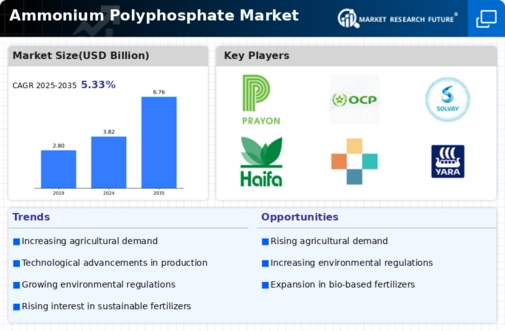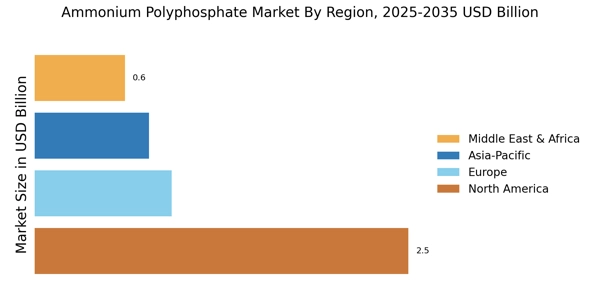Rising Demand in Agriculture
The Ammonium Polyphosphate Market is experiencing a notable surge in demand due to its essential role as a fertilizer. As agricultural practices evolve, the need for efficient nutrient delivery systems becomes paramount. Ammonium polyphosphate, known for its high nutrient content, is increasingly favored by farmers seeking to enhance crop yields. Recent data indicates that The Ammonium Polyphosphate Market is projected to grow at a compound annual growth rate of approximately 3.5% over the next few years. This growth is likely to drive the demand for ammonium polyphosphate, as it is utilized in various formulations to meet the nutritional needs of crops. Furthermore, the increasing focus on sustainable agriculture practices may further bolster the adoption of this compound, as it aligns with the goals of improving soil health and reducing environmental impact.
Increasing Focus on Food Security
The Ammonium Polyphosphate Market is closely tied to the global emphasis on food security. As populations continue to rise, the demand for food production intensifies, necessitating the use of effective fertilizers to maximize agricultural output. Ammonium polyphosphate serves as a critical component in achieving higher crop productivity, thereby addressing food supply challenges. Recent estimates suggest that by 2050, food production must increase by nearly 70% to meet the needs of the growing population. This urgent requirement is likely to propel the demand for ammonium polyphosphate, as it provides essential nutrients that enhance plant growth and resilience. Consequently, the market is expected to witness robust growth as stakeholders prioritize solutions that contribute to sustainable food production.
Expansion of the Chemical Industry
The Ammonium Polyphosphate Market is poised for growth due to the expansion of the chemical sector. As various industries, including agriculture, food processing, and manufacturing, continue to evolve, the demand for specialty chemicals, including ammonium polyphosphate, is likely to rise. The chemical industry is projected to grow at a steady pace, driven by innovations and the need for advanced materials. This expansion creates opportunities for ammonium polyphosphate, as it is utilized in diverse applications beyond fertilizers, such as flame retardants and food additives. The versatility of ammonium polyphosphate positions it favorably within the chemical market, potentially leading to increased production and consumption. As industries seek to enhance product performance and safety, the demand for ammonium polyphosphate may experience a corresponding increase.
Environmental Regulations and Compliance
The Ammonium Polyphosphate Market is increasingly influenced by environmental regulations aimed at promoting sustainable agricultural practices. Governments and regulatory bodies are implementing stringent guidelines to minimize the environmental impact of fertilizers. Ammonium polyphosphate, being a more environmentally friendly option compared to traditional fertilizers, is likely to benefit from these regulations. The market is witnessing a shift towards products that comply with safety and environmental standards, which may enhance the appeal of ammonium polyphosphate among consumers. Furthermore, as awareness of environmental issues grows, farmers are more inclined to adopt fertilizers that align with sustainable practices. This trend could lead to increased market penetration for ammonium polyphosphate, as it is perceived as a viable solution for reducing ecological footprints.
Technological Advancements in Production
Technological innovations within the Ammonium Polyphosphate Market are significantly influencing production efficiency and product quality. Advances in manufacturing processes, such as improved synthesis techniques and enhanced quality control measures, are enabling producers to create higher purity ammonium polyphosphate. This is particularly relevant as the market increasingly demands products that meet stringent quality standards. Moreover, the integration of automation and digital technologies in production facilities is likely to streamline operations, reduce costs, and enhance overall productivity. As a result, manufacturers are better positioned to respond to the growing needs of the agricultural sector, which is projected to expand in the coming years. The ability to produce ammonium polyphosphate more efficiently may also lead to competitive pricing, further stimulating market growth.


















Leave a Comment